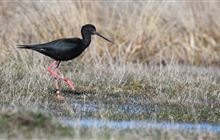Record flock of rare stilts freed in Mackenzie
Archived content: This media release was accurate on the date of publication.
Introduction
A record number of endangered black stilt/kakī have been released into the wild in the Mackenzie basin this week after the best breeding season ever.Date: 09 August 2018
Overall 183 kakī were hatched and reared for release by DOC and The Isaac Conservation and Wildlife Trust, up from 111 in the previous season.
Most of the young waders will be set free at sites in the Tasman and Godley valleys this week, including 45 at Mount Gerald Station today, while 44 younger birds were released last summer.
DOC Twizel Operations Manager, Sally Jones, says the top breeding season is in part due to the success of extensive trapping in the Tasman valley.
“We’ve seen a significant increase in adult kakī pairs in the Tasman valley where we trap predators over 23,000 hectares, which has allowed us to harvest more eggs for incubation.
“The Isaac Conservation and Wildlife Trust has also provided extra support this year, raising 49 young kakī for release.
“The Trust has supported kakī recovery for 25 years and raised many hundreds of young birds at their captive breeding centre in Christchurch, which has been a major contribution to the kakī conservation programme.”
Landowners have also helped by allowing access and predator control on their land including Glentanner and Mount Cook stations, and Mount Gerald Station, where kakī were released today, says Sally Jones.
“The owners of Mount Gerald Station, have been really supportive, letting DOC trap predators and providing accommodation for DOC rangers to feed and monitor kakī for several weeks after they are set free.”
Controlling stoats, ferrets and feral cats is critical for kakī to survive in their natural habitat. Without predator control fewer than 30% of young birds survive to become adults but in areas with trapping like the Tasman valley, the survival rate is 50%.
This summer, for the first time recorded in recent history, a pair of wild kakī successfully hatched and raised three chicks outside of the Mackenzie basin, in the upper Rangitata River—an area where DOC is also trapping predators. These birds have since returned to the Godley valley in the Mackenzie basin.
The kakī population has been slowly increasing in the wild from a low of 23 birds in the 1980s to a recent count of 132 adult birds today. The intensive captive rearing of young birds is vital to sustain and grow the wild population.
Kakī are only found in the braided rivers and wetlands of the upper Waitaki and Mackenzie basins, although they can occasionally be seen in other parts of the country. It is one of New Zealand’s most threatened birds.
Background information
The Isaac Conservation and Wildlife Trust was founded by Sir Neil and Lady Diana Isaac in the 1970s as part of their commitment to conservation. The Trust assists in breeding programmes for endangered native birds and other species. It currently breeds kakī/black stilt, pāteke/brown teal, whio/blue duck, kākāriki karaka/orange-fronted parakeet, New Zealand shore plover and skinks at its wildlife breeding facility at Harewood.
This past season a record 264 eggs were collected from wild and captive kakī pairs and incubated at DOC’s captive rearing facility at Twizel and the Trust’s facilities. Of these 183 chicks survived to fledging.
Contact
For media enquiries contact:
Email: media@doc.govt.nz

